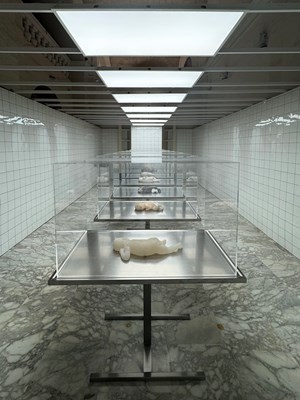
Sofie Muller's (° 1974, Ghent) complex oeuvre displays an ongoing, profound research of the human condition and the beauty of our individual vulnerability. The main recurring themes are imperfection and psycho-physical trauma. She taps into the breaking point of the mind and body and portrays it in smoke drawings and sculptures in bronze or alabaster.
Sofie Muller's installation titled ‘The Clean Room’ is one of thematic pavilions of maltabiennale.art 2024 and is hosted by the National Museum of Archeology in Valletta.
The Clean Room recreates the sterile hospital environment by adding LED lighting and white medical tiles to the space that already has a beautiful marble floor. Seven alabaster baby sculptures are installed on simple metal medical tables covered by transparent boxes and invite the visitors to experience The Clean Room by walking quietly and observe the sculptures. This work refers to the very beginning of our existence and fragility and vulnerability of this moment.
Muller's work has multiple layers. Together with curators, Azad Asifovich and Asli Samadova, she hopes to touch people and let them reflect about ethical questions of reproductive technologies, ecology, wars. Her work is about how far we can go in our quest to create the perfect baby in a society that is determined by evolution, technology and genetic engineering. A wonderful dialogue is created by placing the contemporary alabaster sculptures next to the artifacts in the National Museum of Archeology. This museum has a unique collection of prehistoric fertility figurines. By looking at them we learn how the earliest sculptors of the time depicted the beginning of life.
Each stone that she uses had already a particular life and was formed by nature before. In her work, nature is the primary sculptor. Alabaster is a stone that has a very wide range of colours (white, pink, grey, brown, black and blue) and diverse structures of crystals and cracks in the stones. This variety and unique imperfections are reminiscent to human skin.
For The Clean Room, Sofie Muller used multiple varieties of alabaster, sometimes composing the sculpture from several stones different in texture and colour. One baby sculpture was created from the most perfect alabaster stone she could find. The baby is the ‘perfect baby’ in the series.
The Clean Room is an ongoing project she started in 2017 after reading the book ’the makeble baby’ by Petra De Sutter. At that time she was gynecologist and Professor in reproductive medicine at the University Ghent. Nowadays she is deputy Prime Minister in Belgium.
The Clean Room has its first public presentation in Malta. It took seven years to find the right moment to present it and this opportunity came with an open call for the Malta biennale.
More info on the Malta Biennale :https://maltabiennale.art

ArtDependence Magazine is an international magazine covering all spheres of contemporary art, as well as modern and classical art.
ArtDependence features the latest art news, highlighting interviews with today’s most influential artists, galleries, curators, collectors, fair directors and individuals at the axis of the arts.
The magazine also covers series of articles and reviews on critical art events, new publications and other foremost happenings in the art world.
If you would like to submit events or editorial content to ArtDependence Magazine, please feel free to reach the magazine via the contact page.